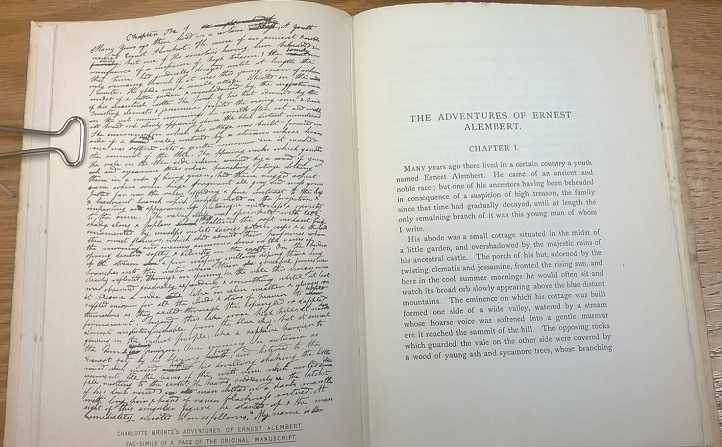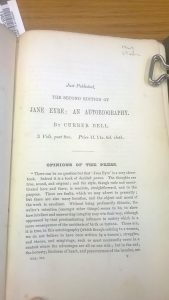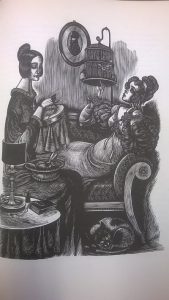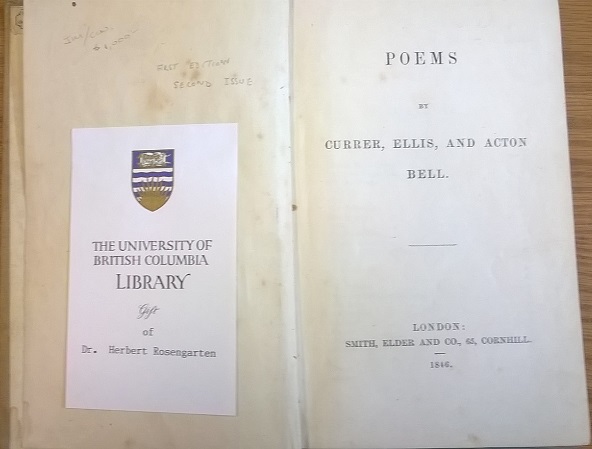Many thanks to guest blogger Paige Hohmann, a graduate student at UBC’s School School of Library, Archival and Information Studies, for contributing the below post!
“Time is the longest distance between two places.” – Tennessee Williams
This week marks the 200th anniversary of the birth of Charlotte Brontë on April 21, 1816, and as writer Ian Frazier has said, “Every once in a while, people need to be in the presence of things that are really far away.”
The lives of the Brontës are familiar to many. The six Brontë siblings, motherless from early ages, lived, in many ways, tragic lives. All died young – two in childhood of tuberculosis, which had also claimed their mother. The four siblings that survived to adulthood – Charlotte (1816-1855), Patrick Branwell (1817-1848), Emily (1818-1848), and Anne (1820-1849) – rose to literary prominence that would endure.
Three sisters, Charlotte, Emily, and Anne Brontë, initially published pseudonymously under the respective pen names Currer, Ellis, and Acton Bell. All three wrote novels that would become cannon in Victorian and Gothic Literature (Jane Eyre for Charlotte, Wuthering Heights for Emily, and The Tenant and Wildfell Hall for Anne).
In a “biographical notice” written in 1850 and published in the preface of the 1922 edition of Wuthering Heights (p. xiv, PR4172 .W9 1922), Charlotte Brontë (as Currer Bell) describes the trajectory of herself and her sisters as poets and novelists:
We had very early cherished the dream of one day becoming authors. This dream, never relinquished even when distance divided and absorbing tasks occupied us, now suddenly acquired strength and consistency; it took the character of resolve. We agreed to arrange a small selection of our poems, and, if possible, get them printed. Averse to personal publicity, we veiled our own names under those of Currer, Ellis, and Acton Bell; the ambiguous choice being dictated by a soft of conscientious scruple at assuming Christian names positively masculine, while we did not like to declare ourselves women, because – without at that time suspecting that our mode of writing and thinking was not what is called “feminine” – we had a vague impression that authoresses are liable to be looked on with prejudice ; we had noticed how critics sometimes use for their chastisement the weapon of personality, and for their reward, flattery which is not true praise.
The Brontë sisters are noteworthy not only for their writing talent, but also for a worldly sophistication and comprehension of gender dynamics that has a contemporary ring. Charlotte Brontë, specifically, in applying this insight to her writing was successful in Jane Eyre in producing:
Almost all that we require in a novelist… :perception of character and power of delineating it; picturesqueness, passion, and knowledge of life. This story is not only of singular interest, naturally evolved, unflagging to the last, but it fastens itself upon your attention and will not leave you (Westminster Review,1848. Reproduced in the “Opinions of the Press” prefatory section of the second edition).

The Adventures of Ernest Alembert: A Fairy Tale, edited by Thomas J. Wise. London: Thomas J. Wise, for private circulation only, 1896. One of only thirty copies. PR4167 .A3 1896
In honour of her 200th birthday, RBSC would like to highlight some of our collection rare and special works by Charlotte Brontë and her sisters on our blog.
This rare book – The Adventures of Ernest Alembert – was in general Library circulation until January 1980, but was identified (by Professor Emeritus of English Herbert J. Rosengarten, who is also responsible for the collection bearing his name) for transfer to RBSC due to its great rarity, both as a limited edition of an unusual text, and as a production of T.J. Wise.
Wise, for his part, was a bibliographer of renown in the 19th and early 20th centuries – and also an infamous forger and thief. RBSC has a number of items in the Thomas J. Wise Collection relating to his career. The book contains two facsimiles of pages of the original 1830 manuscript (where the cursive hand is evident). The original manuscript resides today in the Carl H. Pforzheimer Library, NYPL.

Jane Eyre : an autobiography by Currer Bell ; in three volumes, London: Smith, Elder, 1848. PR4167 .J2 1848
Another gem from the Herbert J. Rosengarten Collection is a second edition of Jane Eyre, which includes a number of features not present in the first edition that makes it particularly valuable to researchers. The book include extracts of contemporary book reviews following Jane Eyre’s initial publication (pictured left). From the wisdom afforded by temporal distance, today’s reader can smile at the irony a review from The Examiner:
There are, it is true, in this autobiography (which though relating to a woman, we do not believe to have been written by a woman), struggles and throes, and misgivings… We confess that we like an author who throws himself into the front of the battle, as the champion of the weaker party; and when this is followed up by bold and skillful soldiership, we are compelled to yield him our respect.
This edition is also the first to have a plate stating dedication of the novel to William Makepeace Thackeray (author of Vanity Fair, PR5618 .A1 1849 at RBSC), and, also unlike the first edition, has a preface by the author herself. In addition to thanking the public, the press, and the publishers, and a “miscellaneous remark” that contextualizes both the text’s literary themes and the disposition of Brontë as a woman writer in a man’s world: “Conventionality is not morality. Self-righteousness is not religion. To attack the first is not to assail the last… Men too often confound them; they should not be confounded ; appearance should not be mistaken for truth.”
See further commentary on the preface courtesy of the British Library’s Victorian and Romantic Literature collection.

Jane Eyre, with wood engravings by Fritz Eichenberg, New York: Random House, 1943. PR4167 .J2 1943
Now out of print, this mid-century edition of Jane Eyre (at right) is a feast for the eyes. You can read more on the wood cuts by Fritz Eichenberg in The Wood and the Graver: The Work of Frize Eichenberg by Alan Fern, available at NE1112.E32 A47 1977 in the Music, Art and Architecture Library, two floors up from RBSC.
This volume of poetry (below), an anthology jointly authored by all three Brontë sisters under their assumed pen names, represents their first published work. The first issue (Aylott and Jones, 1846) sold poorly, but the edition was reissued by Smith, Elder & Co. in 1848. Re-issued again after the success of Jane Eyre in 1850, the book at last became a success.
As April 21 is also “Put a Poem in Your Pocket Day,” please enjoy “Faith and Despondency” by Ellis Bell:
The winter wind is loud and wild,
Come close to me by darling child;
Forsake they books, and mateless play;
And, while the night is gathering grey,
We’ll talk its pensive hours away.

Poems by Currer, Ellis, and Acton Bell, 1st edition, 2nd issue. London: Smith, Elder and Co., 1846. PR4167 .P6 1848
Beyond the titles mentioned above , RBSC has a number of additional works by Charlotte, Emily, and Anne Bronte. A list is provided below, or you can ask one of our friendly staff for assistance.
Articles on the Brontës : [a collection of articles extracted from magazines and reviews between 1849 and 1886]. From the library of the late Earl of Rosebery, K.G.
PR4168 .A8
Bronte Poems: selections from the poetry of Charlotte, Emily, Anne and Branwell Brontë. Published by J. Murray, 1915. PR10.S2 B4 1915 B7
Jane Eyre : an autobiography by Currer Bell ; in three volumes. London: Smith, Elder, 1848.
PR4167 .J2 1848
Jane Eyre, by Charlotte Brontë, with wood engravings by Fritz Eichenberg. New York: Random House, 1943.
PR4167 .J2 1943
Poems by Currer, Ellis, and Acton Bell, 1st edition, 2nd issue. London: Smith, Elder and Co., 1846. PR4167 .P6 1848
The Adventures of Ernest Alembert: A Fairy Tale, by Charlotte Bronte, edited by Thomas J. Wise. London: Thomas J. Wise, for private circulation only, 1896. One of only thirty copies.
PR4167 .A3 1896
The Life of Charlotte Bronte / by E.C. Gaskell (Elizabeth Gaskell) in two volumes. London : Smith, Elder & Co., 1857. PR4168 .G212 1857
The Tenant of Wildfell Hall and Agnes Grey, by Anne Brontë. With twelve coloured illustrations by Edmund Dulac. London & Toronto, J.M. Dent & Sons; New York, E.P. Dutton & Co., 1922.
PZ7.B765 Tn 1922
Wuthering Heights, by Emily Brontë. With six coloured illustrations by Edmund Dulac. London & Toronto, J.M. Dent & Sons; New York, E.P. Dutton & Co., 1922. PR4172 .W9 1922